Patient data is the backbone of quality care. From medical histories and lab results to insurance claims and prescriptions, accurate and accessible records are essential for efficient diagnosis, treatment, and coordination among healthcare providers.
However, many hospitals, clinics, and healthcare organizations still struggle with outdated paper-based systems, leading to inefficiencies, data silos, and security risks.
Optical Character Recognition (OCR) technology is transforming healthcare. OCR enables the digitization of patient records by converting printed and handwritten documents into machine-readable text.
By integrating OCR with Electronic Health Record (EHR) systems, healthcare providers can significantly reduce administrative burdens, enhance data accuracy, and ensure compliance with strict regulations like HIPAA (Health Insurance Portability and Accountability Act) and GDPR (General Data Protection Regulation).
As healthcare organizations worldwide move toward digital transformation, OCR is proving to be an indispensable tool for streamlining operations and enhancing patient outcomes.
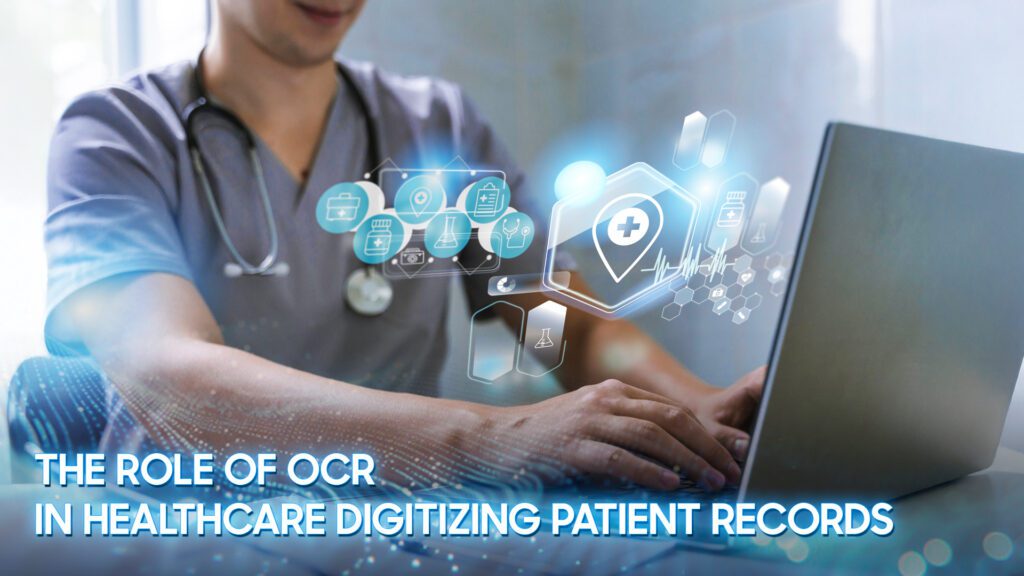
What is OCR?
OCR is a transformative technology that converts printed, typed, or handwritten text into machine-readable data. At its core, OCR uses advanced pattern recognition and artificial intelligence (AI) to extract text from physical documents, allowing them to be stored, searched, and edited digitally.
In healthcare, where vast amounts of patient data exist in non-digital formats, such as medical records, prescriptions, insurance forms, and handwritten notes, OCR plays a crucial role in bridging the gap between traditional record-keeping and modern Electronic Health Record (EHR) systems. By automating the conversion of paper-based information into structured digital formats, OCR eliminates the need for manual data entry, reducing errors and improving efficiency.
How OCR Works:
Healthcare documents, like medical records, prescriptions, and lab reports, are often handwritten, unstructured, and low-quality, making them too complex for traditional OCR. That’s why more organizations are adopting AI-powered OCR, which can handle this complexity and accurately extract structured data.
AI/ML Integrated OCR technology follows a multi-step process:
1. Image Acquisition: Medical documents are scanned or captured as images using hospital scanners, mobile devices, or cameras at clinics.
2. Smart Preprocessing: AI automatically enhances image quality by correcting skew, reducing noise, improving contrast, and detecting text zones, even on handwritten or blurry documents.
3. Text Detection: Deep learning models identify and isolate areas containing text, regardless of layout complexity or poor alignment.
4. Text Recognition: Advanced OCR engines powered by AI recognize printed and handwritten text in multiple fonts and formats, even in low-quality scans.
5. Postprocessing & Error Correction: AI corrects common recognition errors (e.g., distinguishing “O” from “0”), standardizes data formats (e.g., dates, units), and improves accuracy.
6. NLP & Context Understanding: Natural Language Processing helps interpret medical terms, expand abbreviations (e.g., “HTN” → Hypertension), and identify key entities like patient names, diagnoses, and medication.
7. Display Results on EHR System: Extracted data is structured and automatically pushed to the Electronic Health Record (EHR) system, making patient information immediately accessible for healthcare providers.
- Image Acquisition – A document is scanned or captured as an image using a camera, scanner, or mobile device.
- Preprocessing – The image is enhanced by removing noise, adjusting contrast, and correcting distortions to improve accuracy.
- Text Recognition – The system analyzes characters, words, and structures using AI-driven algorithms to extract meaningful data.
- Post Processing & Data Structuring – The recognized text is refined, formatted, and converted into a structured digital format, making it usable within databases, EHRs, and healthcare applications.
⇒ Find out more details about how OCR works here
OCR in Other Industries vs Healthcare
OCR has been widely adopted across industries such as banking, legal services, and logistics to digitize documents and automate workflows. However, its role in healthcare is particularly impactful due to the industry’s reliance on handwritten medical notes, unstructured patient records, and regulatory compliance requirements. Unlike other sectors, healthcare OCR solutions must handle complex medical terminologies, diverse handwriting styles from physicians, and varying document formats, requiring sophisticated AI and Natural Language Processing (NLP) integration for higher accuracy.
The Challenges of Paper-Based Patient Records
Despite the rapid digital transformation in healthcare, many hospitals, clinics, and medical institutions still rely heavily on paper-based patient records. While traditional record-keeping has been in place for decades, it presents significant challenges that hinder efficiency, accuracy, and overall patient care. The reliance on physical documents contributes to administrative inefficiencies, medical errors, compliance risks, and increased operational costs.
1. Inefficiencies in Managing Physical Records
Handling paper-based medical records is a time-consuming and resource-intensive process. Physicians, nurses, and administrative staff must manually retrieve, update, and store records, which slows down workflows.
(1) A study by Yilmaztürk et al. (2023), conducted in the intensive care units (ICUs) of a university hospital in Istanbul, found that nurses spent an average of 56.8 minutes per day per bed filling out paper forms. Once digitized, this time was significantly reduced, resulting in 760 care days saved annually and an estimated 13 million USD in cost savings across Turkey’s ICU system.
Moreover, searching for a patient’s past medical history in a sea of files is prone to delays, especially in emergency situations where immediate access to records is critical. Misplaced or lost documents can lead to treatment delays, forcing doctors to repeat tests or procedures, increasing both time and financial burdens on the healthcare system
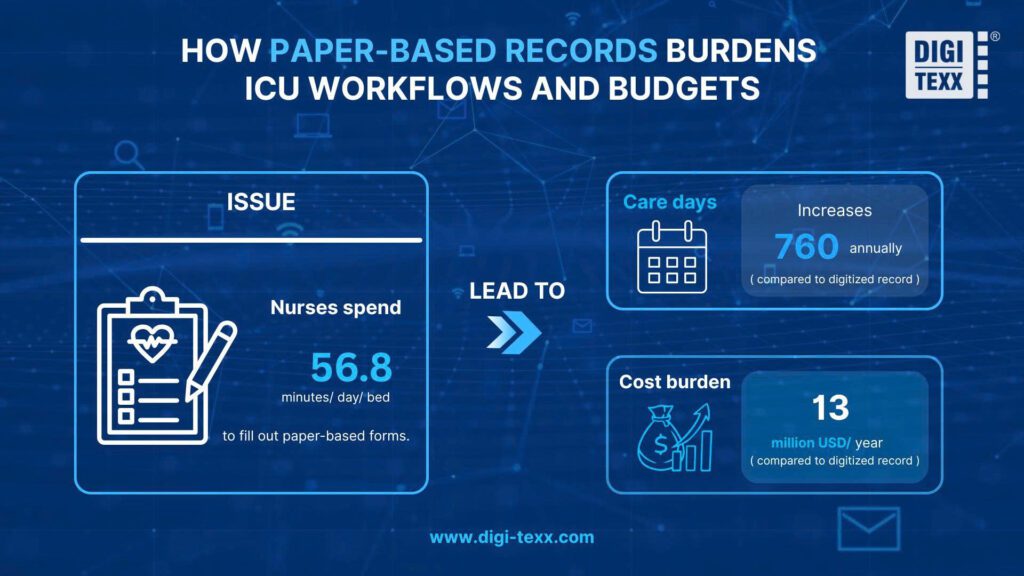
2. Increased Risk of Data Loss and Damage
Unlike digital records stored in cloud-based databases, physical documents are vulnerable to loss, theft, and environmental damage. Fires, floods, or accidental misplacement can result in permanent loss of critical patient information, affecting long-term treatment plans and continuity of care.
Additionally, human handling increases the likelihood of misfiling records, making retrieval difficult. A single misplaced medical chart can lead to incorrect diagnoses, delayed treatments, or redundant medical tests, potentially putting patients at risk.
3. Higher Likelihood of Medical Errors
Medical errors are a leading cause of preventable harm and fatalities in healthcare. Illegible handwriting on prescriptions, patient charts, or lab reports can result in misinterpretations, incorrect dosages, and even life-threatening medication errors.
For example, a misread prescription due to poor handwriting or document degradation could lead to a patient receiving the wrong medication or an incorrect dosage, with severe health consequences. Research has shown that medication errors affect at least 1.5 million people annually in the U.S. alone, and a significant percentage of these errors stem from documentation issues.
4. Compliance and Security Challenges
Regulatory compliance in healthcare is strict, with laws such as HIPAA (Health Insurance Portability and Accountability Act) in the U.S. and GDPR (General Data Protection Regulation) in Europe enforcing stringent data privacy and security measures. Paper-based records present compliance challenges due to:
- Lack of audit trails – Unlike digital records, paper documents do not provide a log of who accessed or modified them, making it difficult to track unauthorized use.
- Inadequate security – Physical records are often stored in unsecured cabinets or filing systems, making them susceptible to unauthorized access, theft, or tampering.
- Difficulty in enforcing data retention policies – Healthcare organizations must retain patient records for a legally mandated period. However, maintaining physical archives over decades is impractical and prone to deterioration.
Failure to comply with data security and patient confidentiality regulations can result in hefty fines, legal consequences, and reputational damage for healthcare providers.
5. Scalability and Cost Burdens
As hospitals and clinics grow, so does the volume of patient data. Paper records require significant physical storage space, leading to higher operational costs for facilities that must allocate resources to maintain, organize, and retrieve files. Larger healthcare institutions may spend millions annually on record-keeping infrastructure, while smaller clinics struggle with limited space and staff availability.
Moreover, printing, copying, and transporting paper records add to operational costs. Transitioning to digital records through OCR-powered solutions can help reduce administrative expenses and allow healthcare providers to allocate resources toward improving patient care.
6. Limited Interoperability and Data Sharing
Modern healthcare relies on seamless data exchange between hospitals, pharmacies, insurance providers, and specialists. However, paper-based systems create silos, making it difficult to share critical patient information across different healthcare entities.
For example, if a patient visits a specialist at a different hospital, their previous medical records may not be readily available, leading to duplicate tests, fragmented care, and potential treatment delays. The lack of real-time data accessibility negatively impacts care coordination, especially for patients with chronic conditions requiring ongoing monitoring.
How OCR is Transforming Healthcare
OCR enables the digitization of medical documents, converting printed and handwritten records into structured electronic formats that can be seamlessly integrated into EHRs, billing systems, and healthcare analytics platforms.
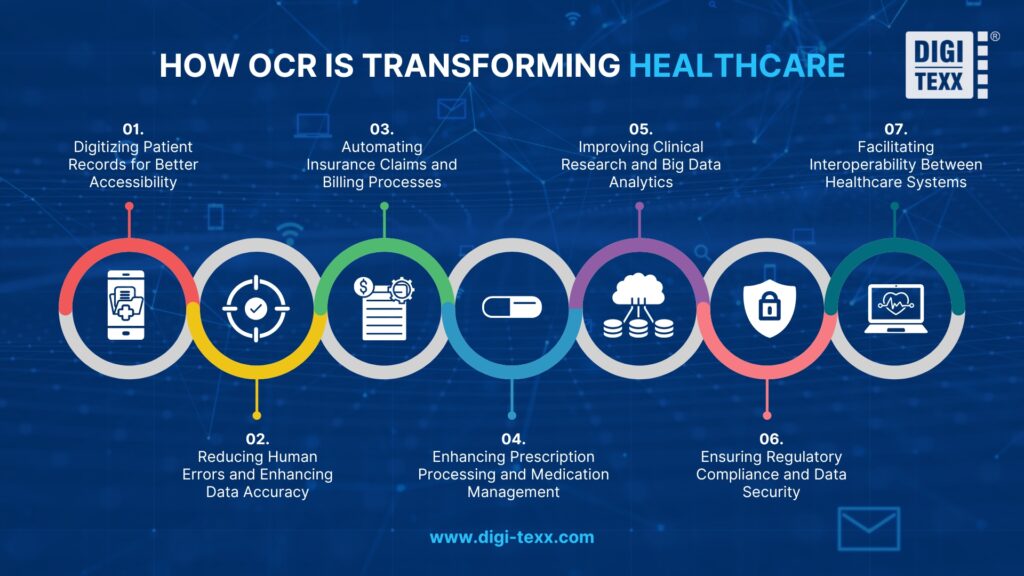
1. Digitizing Patient Records for Better Accessibility
Historically, healthcare providers relied on paper-based medical records, which were difficult to manage, prone to loss, and required extensive physical storage. OCR solves this issue by converting handwritten doctor notes, prescriptions, lab reports, and patient intake forms into searchable, editable, and digitally stored records.
Key Benefits:
- Faster Record Retrieval – Doctors can instantly access patient histories without sifting through physical files.
- Improved Care Coordination – Digital records facilitate seamless data exchange between hospitals, clinics, and specialists.
- Enhanced Emergency Care – In critical situations, quick access to digitized medical records can be life-saving.
2. Reducing Human Errors and Enhancing Data Accuracy
One of the biggest risks in healthcare is medical errors, often caused by the misinterpretation of handwritten notes and manual data entry mistakes. (2) According to Nukpezah, Anyaba, and Osman (2024), 81.8% of pediatric nurses reported that illegible handwriting on medication orders contributed to medication administration errors, highlighting a serious threat to patient safety in clinical settings.
This highlights the urgent need to eliminate ambiguity in medical documentation, a challenge that OCR technology can address by converting handwritten records into digital formats and improving accuracy throughout clinical workflows.
OCR eliminates ambiguity in medical documentation by:
- Accurately transcribing handwritten prescriptions, diagnoses, and treatment plans.
- Standardizing medical terminology and patient information across different healthcare systems.
- Reducing manual data entry workloads, minimizing human errors, and improving clinical decision-making.
3. Automating Insurance Claims and Billing Processes
Medical billing and insurance claims processing are often complex and time-consuming, with high risks of errors and rejections due to incorrect or incomplete information. OCR helps healthcare providers and insurers by:
- Extracting patient information from medical forms and automatically filling in digital claim submissions.
- Verifying medical codes, reducing claim denials, and expediting reimbursements.
- Improving fraud detection by cross-referencing patient records with billing details.
Impact on Healthcare:
- Speeds up claim approvals – Reducing reimbursement wait times for hospitals and patients.
- Minimizes billing discrepancies – Ensures accurate medical coding and reduces financial losses.
- Enhances patient experience – Streamlining billing reduces confusion and delays in payments.
4. Enhancing Prescription Processing and Medication Management
Handwritten prescriptions can be illegible or misinterpreted, leading to dangerous medication errors. OCR technology is revolutionizing prescription handling by:
- Scanning and digitizing handwritten prescriptions, ensuring accuracy in medication dispensing.
- Integrating with pharmacy management systems to flag potential drug interactions or dosage errors.
- Reducing the risk of counterfeit prescriptions by cross-verifying with EHR systems.
For example, many pharmacies now use OCR-powered prescription scanners, allowing pharmacists to instantly convert handwritten prescriptions into digital records, reducing errors and ensuring that patients receive the correct medications.
5. Improving Clinical Research and Big Data Analytics
OCR is accelerating medical research and innovation by unlocking valuable insights from historical patient records, clinical trial documents, and handwritten doctor notes. Traditionally, researchers had to manually analyze paper-based patient records, but OCR allows for:
- Rapid digitization and analysis of decades-old medical data for research purposes.
- Identification of disease patterns and trends using AI-driven healthcare analytics.
- Improved epidemiological tracking by processing large volumes of patient data quickly.
6. Ensuring Regulatory Compliance and Data Security
Healthcare regulations require strict data protection and access control to maintain patient confidentiality. OCR enhances compliance by:
- Encrypting and securing patient records to prevent unauthorized access.
- Creating an audit trail for document access and modifications, ensuring transparency.
- Automatically redacting sensitive patient information in legal or insurance-related documents.
Key Benefits:
- Stronger security measures – Protecting patient data from breaches and cyber threats.
- Easier compliance reporting – Automating regulatory audits and HIPAA compliance checks.
- Improved patient trust – Ensuring confidentiality and ethical handling of medical data.
7. Facilitating Interoperability Between Healthcare Systems
Interoperability, the seamless exchange of data between different healthcare providers, insurers, and government agencies, is a key challenge in modern healthcare. OCR helps bridge the gap by:
- Converting disparate medical documents into standardized digital formats.
- Enabling easy data sharing across hospitals, labs, pharmacies, and insurance providers.
- Integrating with AI-powered chatbots and virtual assistants to provide instant medical information retrieval.
With OCR-powered real-time data exchange, doctors can access comprehensive patient histories instantly, leading to faster diagnoses and more personalized treatment plans.
Key Applications of OCR in Healthcare
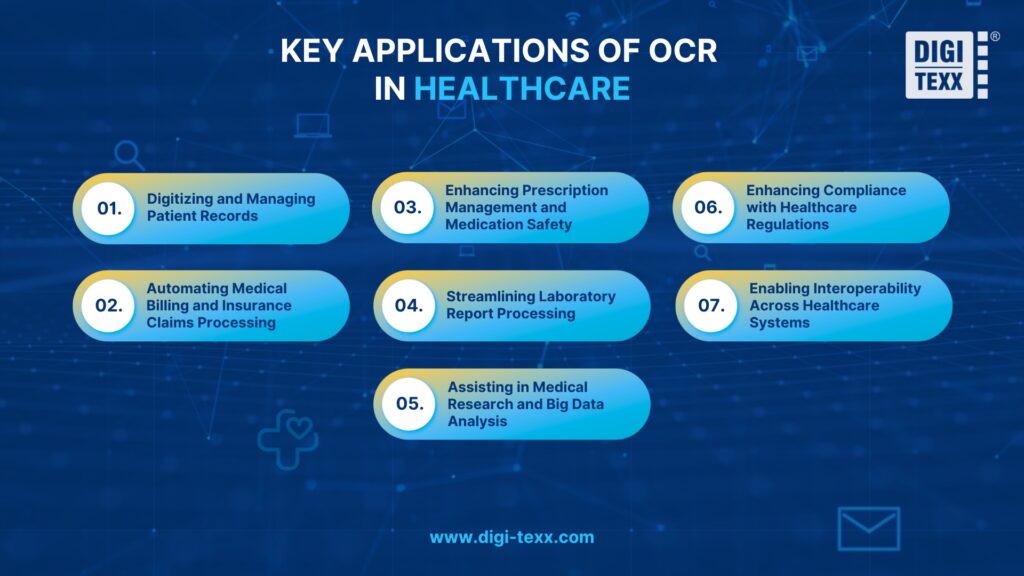
| Application | How OCR Helps | Impact on Healthcare |
| Digitizing and Managing Patient Records | • Scans and digitizes old paper records, making them searchable and easy to retrieve. • Integrates digitized data into Electronic Health Record (EHR) systems, improving accessibility. • Reduces the risk of misplaced or lost medical records, ensuring continuity of care. | • Doctors and specialists can instantly retrieve medical histories. • Eliminates the need for large physical archives. • Reduces wait times for medical consultations. |
| Automating Medical Billing and Insurance Claims Processing | • Extracts patient details, diagnosis codes, and treatment costs from paper-based insurance forms. • Automates data entry into hospital billing systems, reducing administrative workload. • Validates claim information for accuracy, reducing rejection rates. | • Speeds up reimbursement processes for both patients and providers. • Reduces paperwork and manual labor. • Minimizes errors that could lead to claim denials. |
| Enhancing Prescription Management and Medication Safety | • Digitizes handwritten prescriptions, ensuring accurate data entry into pharmacy systems. • Cross-checks prescriptions with patient medical history to prevent drug interactions. • Integrates with e-prescription systems to reduce reliance on handwritten notes. | • Improves prescription accuracy and patient safety. • Ensures pharmacies maintain digital copies for future reference. • Reduces delays in dispensing medications. |
| Streamlining Laboratory Report Processing | • Extracts key data from lab reports (e.g., blood test results, imaging findings). • Automatically uploads structured data into patient EHRs, making reports accessible instantly. • Flags abnormal results for faster review by doctors. | • Quicker diagnosis and treatment – Doctors get instant access to lab results. • Reduced paperwork burden – Laboratories operate more efficiently. • Better patient monitoring – Helps track trends in test results over time. |
| Assisting in Medical Research and Big Data Analysis | • Digitizes and organizes years of archived medical records for research analysis. • Enables AI-driven analytics by converting unstructured text into structured data. • Supports epidemiological studies by providing real-world patient data insights. | • Faster disease research – Identifies trends and risk factors using AI-driven insights. • Better clinical trial management – Automates data extraction from consent forms and trial reports. • Improved patient outcomes – Research findings lead to more effective treatments. |
| Enhancing Compliance with Healthcare Regulations | • Encrypts digitized patient records for secure storage and retrieval. • Redacts sensitive information in legal and insurance-related documents. • Creates an audit trail for document access, ensuring regulatory compliance. | • Stronger data security – Prevents unauthorized access to medical records. • Simplified audits – Makes regulatory reporting easier for healthcare providers. • Increased patient trust – Ensures confidentiality of personal health information. |
| Enabling Interoperability Across Healthcare Systems | • Converts paper-based patient information into standardized digital formats. • Allows real-time access to patient data across hospitals, clinics, and pharmacies. • Integrates with AI-powered healthcare assistants to retrieve relevant medical information instantly. | • Better collaboration between healthcare providers – Enables faster referrals and consultations. • Reduced duplicate testing – Saves costs and prevents unnecessary procedures. • Improved chronic disease management – Enhances real-time tracking of patient conditions. |
Challenges & Considerations for OCR Implementation
Healthcare organizations must navigate technical, operational, and regulatory hurdles to ensure successful integration. Below, we explore the key challenges and considerations for OCR adoption in healthcare and how institutions can address them.
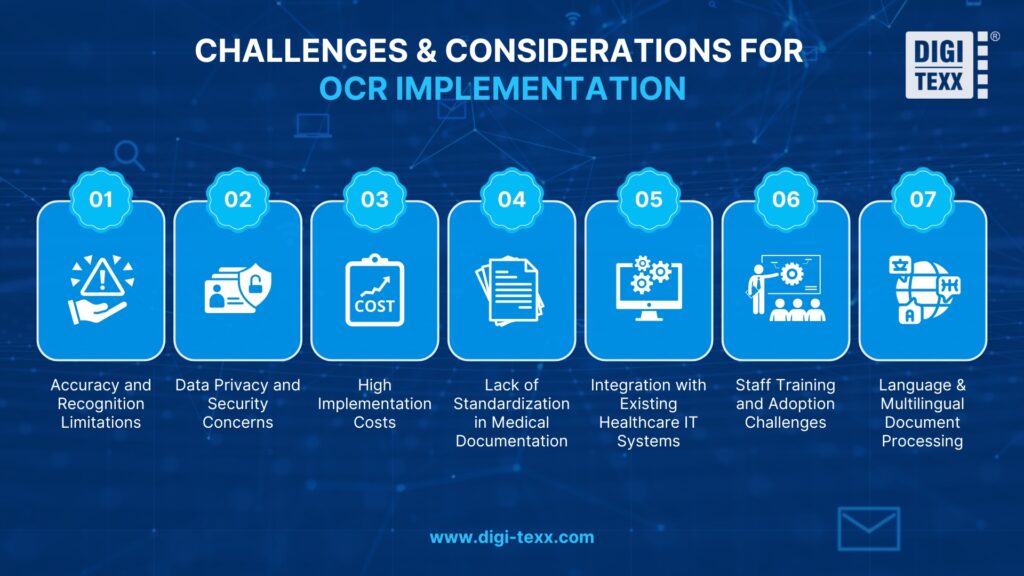
| Challenges | Potential Issues | Solution Approaches |
| Accuracy and Recognition Limitations | • Misinterpretation of medical terms can result in incorrect data entry. • Handwriting variations across different physicians can impact accuracy. • OCR may struggle with complex tables, charts, and diagrams in medical reports | • AI-Powered OCR with Machine Learning (ML) – Modern OCR solutions integrate AI and ML to learn from past errors and improve accuracy over time. • Human-in-the-loop Verification – Implementing manual review processes ensures that OCR-extracted data is cross-checked for accuracy. • Enhanced Image Preprocessing – Techniques such as contrast adjustment and noise reduction improve OCR performance on low-quality scans. |
| Data Privacy and Security Concerns | • Digitized patient records may become targets for cyberattacks and data breaches. • Improper OCR handling can lead to accidental exposure of confidential health data. • Lack of access control measures may result in unauthorized personnel viewing patient records. | • End-to-End Encryption – Encrypting scanned documents ensures that data is protected during transmission and storage. • Role-Based Access Control (RBAC) – Restricting access to digitized records based on user roles minimizes security risks. • Audit Trails & Logging – Maintaining detailed logs of who accessed and modified patient data helps in compliance tracking. |
| High Implementation Costs | • Hardware & Software Expenses – High-quality OCR engines and scanning equipment require a significant investment. • Integration with Existing Systems – Many hospitals already use legacy EHR systems that may not easily support OCR integration. • Ongoing Maintenance & Updates – Keeping OCR solutions optimized for evolving healthcare needs requires continuous improvements. | • Cloud-Based OCR Solutions – Many providers offer pay-as-you-go cloud OCR services, reducing upfront infrastructure costs. • Government & Private Sector Grants – Healthcare organizations can seek funding for digital transformation projects. • Phased Implementation – Start with OCR for high-impact areas (e.g., insurance claims, prescriptions) before expanding. |
| Lack of Standardization in Medical Documentation | • OCR may struggle with unstructured data, leading to inconsistencies in digitized records. • Lack of standardization can create interoperability issues when sharing digitized records across different healthcare networks | • Natural Language Processing (NLP) Integration – Combining OCR with NLP helps interpret and structure medical data more effectively. • Use of Healthcare Data Standards – Implementing standards like FHIR (Fast Healthcare Interoperability Resources) ensures better data consistency. • Customized OCR Models – Training OCR systems on specific hospital document formats improves recognition and adaptability. |
| Integration with Existing Healthcare IT Systems | • OCR systems may not properly communicate with outdated EHR platforms. • Data extracted by OCR may require manual reformatting to fit existing digital workflows. • High IT workload in configuring and maintaining OCR integrations. | • API-Based OCR Integration – Modern OCR solutions offer APIs that connect directly to EHR systems. • Cloud-Based OCR with Interoperability Features – Cloud solutions provide greater flexibility in handling diverse IT environments. • Gradual IT Migration Strategies – Healthcare organizations should incrementally upgrade legacy systems rather than attempt a full overhaul at once. |
| Staff Training and Adoption Challenges | • Staff may be unfamiliar with OCR tools, leading to inefficiencies. • Resistance to change can slow down organization-wide OCR adoption. • Poor training can result in errors in OCR usage, affecting accuracy. | • User-Friendly OCR Interfaces – Implementing intuitive, easy-to-use OCR solutions encourages adoption. • Comprehensive Staff Training Programs – Healthcare providers should conduct hands-on training to ensure a smooth transition. • Phased Rollout with Support Teams – A gradual introduction of OCR tools, supported by IT and training teams, increases acceptance. |
| Language & Multilingual Document Processing | • Standard OCR engines may struggle with non-English medical documents. • Medical records in different languages may not be properly categorized after digitization. • OCR may fail to recognize diacritics or specialized characters in multilingual text | • Multilingual OCR Models – Implementing AI-driven OCR systems that support multiple languages improves accuracy. • Language-Specific Training Data – OCR engines should be trained on region-specific medical records. • Post-OCR Language Translation Tools – AI-based translation services can enhance cross-language data accessibility. |
OCR in Healthcare | Digital Transformation Leads The Way
Implementing OCR in healthcare presents several challenges, including accuracy limitations, high costs, security risks, and integration complexities. However, by leveraging AI-powered OCR, cloud-based solutions, NLP integration, and robust staff training, healthcare providers can overcome these barriers and unlock the full potential of OCR-driven digitization.
As the healthcare industry continues to embrace digital transformation, OCR will play an increasingly vital role in optimizing workflows, enhancing patient care, and ensuring seamless interoperability across healthcare networks.


